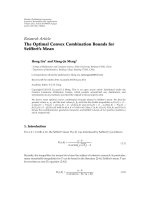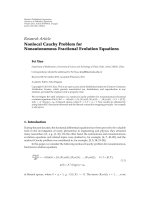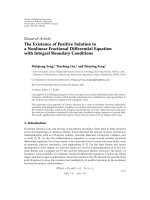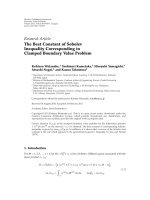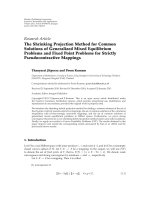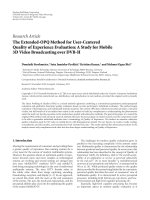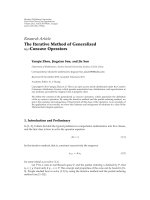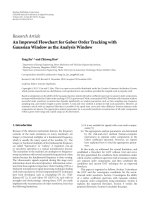báo cáo hóa học:" Research Article The Obstacle Problem for the A-Harmonic Equation" pot
Bạn đang xem bản rút gọn của tài liệu. Xem và tải ngay bản đầy đủ của tài liệu tại đây (494.42 KB, 11 trang )
Hindawi Publishing Corporation
Journal of Inequalities and Applications
Volume 2010, Article ID 767150, 11 pages
doi:10.1155/2010/767150
Research Article
The Obstacle Problem for the A-Harmonic Equation
Zhenhua Cao,
1, 2
Gejun Bao,
2
and Haijing Zhu
3
1
Department of Mathematics, Jiangxi Normal University, Nanchang 330022, China
2
Department of Mathematics, Harbin Institute of Technology, Harbin 150001, China
3
College of Mathematics and Physics, Shandong Institute of Light Industry, Jinan 250353, China
Correspondence should be addressed to Gejun Bao,
Received 9 December 2009; Revised 26 March 2010; Accepted 31 March 2010
Academic Editor: Shusen Ding
Copyright q 2010 Zhenhua Cao et al. This is an open access article distributed under the Creative
Commons Attribution License, which permits unrestricted use, distribution, and reproduction in
any medium, provided the original work is properly cited.
Firstly, we define an order for differential forms. Secondly, we also define the supersolution and
subsolution of the A-harmonic equation and the obstacle problems for differential forms which
satisfy the A-harmonic equation, and we obtain the relations between the solutions to A-harmonic
equation and the solution to the obstacle problem of the A-harmonic equation. Finally, as an
application of the obstacle problem, we prove the existence and uniqueness of the solution to
the A-harmonic equation on a bounded domain Ω with a smooth boundary ∂Ω,wheretheA-
harmonic equation satisfies d
Ax, du0,x∈ Ω; u ρ, x ∈ ∂Ω, where ρ is any given differential
form which belongs to W
1,p
Ω, Λ
l−1
.
1. Introduction
Recently, a large amount of work about the A-harmonic equation for the differential forms has
been done. In 1999 Nolder gave some properties for the solution to the A-harmonic equation
in 1,anddifferent versions of these properties had been established in 2–4. The properties
of the nonhomogeneous A-harmonic equation have been discussed in 5–10. In the above
papers, we can think that the boundary values were zero. In this paper, we mainly discuss
the existence and uniqueness of the solution to A-harmonic equation with boundary values
on a bounded domain Ω.
Now let us see some notions and definitions about the A-harmonic equation
d
Ax, du0.
Let e
1
,e
2
, ,e
n
denote the standard orthogonal basis of R
n
. For l 0, 1, ,n, we
denote by Λ
l
Λ
l
R
n
the linear space of all l-vectors, spanned by the exterior product e
I
e
i
1
∧e
i
2
∧···∧e
i
l
corresponding to all ordered l-tuples I i
1
,i
2
, ,i
l
,1≤ i
1
<i
2
< ···<i
l
≤ n.
The Grassmann algebra Λ⊕Λ
l
is a graded algebra with respect to the exterior products of
α
α
I
e
I
∈ Λ and β
β
I
e
I
∈ Λ, then its inner product is obtained by
α, β
α
I
β
I
1.1
2 Journal of Inequalities and Applications
with the summation over all I i
1
,i
2
, ,i
l
and all integers l 0, 1, ,n. And the norm of
α
α
I
e
I
∈ Λ is given by |α| α, α
1/2
.
The Hodge star operator : Λ
l
→ Λ
n−l
is defined by the rule if ω ω
I
dx
I
ω
i
1
,i
2
, ,i
l
dx
i
1
∧ dx
i
2
···∧dx
i
l
, then
ω
−1
I
ω
I
dx
J
,
1.2
where
Ill 1/2
l
k1
i
k
and J 1, 2, ,n− I. So we have ω−1
ln−l
ω.
Throughout this paper, Ω ⊂ R
n
is an open subset, for any constant σ>1, Q denotes
a cube such that Q ⊂ σQ ⊂ Ω, where σQ denotes the cube whose center is as same as Q
and diamσQσ diam Q. We say that α
α
I
e
I
∈ Λ is a differential l-form on Ω if every
coefficient α
I
of α is Schwartz distribution on Ω. The space spanned by differential l-form
on Ω is denoted by D
Ω, Λ
l
. We write L
p
Ω, Λ
l
for the l-form α
α
I
dx
I
on Ω with
α
I
∈ L
p
Ω for all ordered l-tuple I.ThusL
p
Ω, Λ
l
is a Banach space with the norm
α
p,Ω
Ω
|
α
|
p
dx
1/p
⎛
⎝
Ω
I
|
α
I
|
2
p/2
dx
⎞
⎠
1/p
.
1.3
Similarly W
k,p
Ω, Λ
l
denotes those l-forms on Ω with all coefficients in W
k,p
Ω. We denote
the exterior derivative by
d : D
Ω, Λ
l
−→ D
Ω, Λ
l1
for l 0, 1, 2, ,n 1.4
and its formal adjoint operator the Hodge codifferential operator
d
: D
Ω, Λ
l
−→ D
Ω, Λ
l−1
. 1.5
The operators d and d
are given by the formulas
dα
I
dα
I
∧ dx
I
,d
−1
nl1
d.
1.6
2. The Obstacle Problem
In this section, we introduce the main work of this paper, which defining the supersolution
and subsolution of the A-harmonic equation and the obstacle problems for differential forms
which satisfy the A-harmonic equation, and the proof for the uniqueness of the solution to
the obstacle problem of the A-harmonic equations for differential forms. We can see this work
about functions in 11, Chapter 3 and Appendix I in detail. We use the similar methods in
11 to do the main work for differential forms.
We firstly give the comparison about differential forms according to the comparison’s
definition about functions in R.
Journal of Inequalities and Applications 3
Definition 2.1. Suppose that α
I
α
I
xdx
I
and β
I
β
I
xdx
I
belong to Λ
l
, we say that
α ≥ β if for any given x, we have α
I
x ≥ β
I
x for all ordered l-tuples I i
1
,i
2
, ,i
l
,
1 ≤ i
1
<i
2
< ···<i
l
≤ n.
Remark 2.2. The above definition involves the order for differential forms which we have
been trying to avoid giving. We know that many differential forms can not be compared
based on the above definition since there are so many inequalities to be satisfied. However,
at the moment, we can not replace this definition by another one and we are working on it
now. We just started our research on the obstacle problem for differential forms satisfying
the A-harmonic equation and we hope that our work will stimulate further research in this
direction.
By the some definitions as the solution, supersolution or subsolution to quasilinear
elliptic equation, we can give the definitions of the solution, supersolution or subsolution
to A-harmonic equation
d
A
x, du
0. 2.1
Definition 2.3. If a differential form u ∈ W
1,p
loc
Ω, Λ
l−1
satisfies
Ω
A
x, du
,dϕ
dx 0,
2.2
for any ϕ ∈ W
1,p
0
Ω, Λ
l−1
, then we say that u is a solution to 2.1. If for any 0 ≤ ϕ ∈
W
1,p
loc
Ω, Λ
l−1
, we have
Ω
A
x, du
,dϕdx ≥ 0
≤ 0
,
2.3
then we say that u is a supersolution subsolution to 2.1.
We can see that if u is a subsolution to 2.1, then for 0 ≥ ϕ ∈ W
1,p
0
Ω, Λ
l−1
, we have
Ω
A
x, du
,dϕdx ≥ 0.
2.4
According to the above definition, we can get the following theorem.
Theorem 2.4. Adifferential form u ∈ W
1,p
loc
Ω, Λ
l−1
is a solution to 2.1 if and only if u is both
supersolution and subsolution to 2.1.
Proof. The sufficiency is obvious, we only prove the necessity. For any ϕ ∈ W
1,p
0
Ω, Λ
l−1
,we
suppose that ϕ
I
ϕ
I
dx
I
,
ϕ
1
I
ϕ
I
dx
I
≥ 0,ϕ
2
I
ϕ
−
I
dx
I
≤ 0;
2.5
4 Journal of Inequalities and Applications
by Definition 2.3, it holds that
Ω
A
x, du
,dϕ
1
dx ≥ 0,
Ω
A
x, du
,dϕ
2
dx ≥ 0.
2.6
So
0 ≤
Ω
A
x, du
,dϕ
1
dx
Ω
A
x, du
,dϕ
2
dx
Ω
A
x, du
,dϕ
1
dϕ
2
dx
Ω
A
x, du
,dϕdx.
2.7
Using −ϕ in place of ϕ, we also can get
Ω
A
x, du
,dϕdx ≤ 0.
2.8
Thus
Ω
A
x, du
,dϕdx 0.
2.9
Therefore u is a solution to 2.1.
Next we will introduce the obstacle problem to A-harmonic equation, whose definition
is according to the same definition as the obstacle problem of quasilinear elliptic equation. For
the obstacle problem of quasilinear elliptic equation we can see 11 for details.
Suppose that Ω is a bounded domain. that ψ
I
ψ
I
dx
I
is any differential form in Ω
which satisfies any ψ
I
that is function in Ω with values in the extended reals −∞, ∞,and
ρ ∈ W
1,p
Ω, Λ
l−1
.Let
K
ψ,ρ
Ω, Λ
l−1
v ∈ W
1,p
Ω, Λ
l−1
: v ≥ ψ a.e., v − ρ ∈ W
1,p
0
Ω, Λ
l−1
. 2.10
The problem is to find a differential form in K
ψ,ρ
Ω, Λ
l−1
such that for any v ∈
K
ψ,ρ
Ω, Λ
l−1
, we have
Ω
A
x, du
d
v − u
≥0.
2.11
Definition 2.5. Adifferential form u ∈K
ψ,ρ
Ω, Λ
l−1
is called a solution to the obstacle problem
of A-harmonic equation 2.1 with obstacle ψ and boundary values ρ or a solution to the
obstacle problem of A-harmonic equation 2.1 in K
ψ,ρ
Ω, Λ
l−1
if u satisfies 2.11 for any
v ∈K
ψ,ρ
Ω, Λ
l−1
.
Journal of Inequalities and Applications 5
If ψ ρ, then we denote that K
ψ,ψ
Ω, Λ
l−1
K
ψ
Ω, Λ
l−1
. We have some relations
between the solution to quasilinear elliptic equation and the solution to obstacle problem
in PDE. As to differential forms, we also have some relations between the solution to A-
harmonic equation and the solution to obstacle problem of A-harmonic equation. We have
the following two theorems.
Theorem 2.6. If a differential form u is a supersolution to 2.1,thenu is a solution to the obstacle
problem of 2.1 in K
ψ,u
Ω, Λ
l−1
. For any K
ψ,ρ
Ω, Λ
l−1
,ifu is a solution to the obstacle problem of
2.1 in K
ψ,ρ
Ω, Λ
l−1
,thenu is a supersolution to 2.1 in Ω.
Proof. If u is a solution to the obstacle problem of 2.1 in K
ψ,ρ
Ω, Λ
l−1
, then for any 0 ≤ ϕ ∈
W
1,p
0
Ω, Λ
l−1
, we have v u ϕ ∈K
ψ,ρ
Ω, Λ
l−1
, so it holds that
Ω
A
x, du
,dϕdx
Ω
A
x, du
,dv− dudx ≥ 0.
2.12
Thus u is a supersolution to 2.1 in Ω. Conversely, if u is a supersolution to 2.1 in Ω,
then for any v ∈K
u
Ω, Λ
l−1
, we have
v − u ≥ 0,v− u ∈ W
1,p
0
Ω, Λ
l−1
. 2.13
Thus let ϕ v − u, then we have
0 ≤
Ω
A
x, du
,dϕdx
Ω
A
x, du
,dv− dudx.
2.14
So u is a solution to the obstacle problem of 2.1 in K
ψ,u
Ω, Λ
l−1
.
Theorem 2.7. Adifferential form u is a solution to 2.1 if and only if u is a solution to the obstacle
problem of 2.1 in K
ψ,ρ
Ω, Λ
l−1
with ρ satisfying u − ρ ∈ W
1,p
0
Ω, Λ
l−1
.
Proof. If is a solution to the obstacle problem of 2.1 in K
ψ,ρ
Ω, Λ
l−1
, then for any ϕ ∈
W
1,p
0
Ω, Λ
l−1
, we have v u ϕ u − ρ ρ ϕ ∈K
−∞,ρ
Ω, Λ
l−1
. So we can obtain
Ω
A
x, du
,dϕdx
Ω
A
x, du
,dv− dudx ≥ 0.
2.15
By using −ϕ in place of ϕ, we have
Ω
A
x, du
,d
−ϕ
dx
Ω
A
x, du
,dv− dudx ≥ 0.
2.16
So
Ω
A
x, du
,dϕdx 0.
2.17
Thus u is a solution to 2.1 in Ω.
6 Journal of Inequalities and Applications
Conversely, if u is a solution to 2.1 in Ω, then for any v ∈K
−∞,ρ
Ω, Λ
l−1
, we have
v − u ∈ W
1,p
0
Ω, Λ
l−1
. Now let ϕ v − u, then we have
0
Ω
A
x, du
,dϕdx
Ω
A
x, du
,dv− dudx.
2.18
Thus
0 ≤
Ω
A
x, du
,dv− dudx.
2.19
So the theorem is proved.
The following we will discuss the existence and uniqueness of the solution to the
obstacle problem of 2.1 in K
ψ,ρ
Ω, Λ
l−1
and the solution to 2.1. First we introduce a
definition and two lemmas.
Definition 2.8 see 11. Suppose that X is a reflexive Banach space in Ω with dual space
X
,andlet·, · denote a pairing between X
and X.IfK ⊂ X is a closed convex set, then a
mapping £ : K → X
is called monotone if
£u − £v, u − v
≥ 0, 2.20
for all uv in K. Further, £ is called coercive on K if there exists ϕ ∈ K such that
£u
j
− £ϕ, u
j
− ϕ
u
j
− ϕ
−→ ∞ ,
2.21
whenever u
j
is a sequence in K with u
j
→∞.
By the definition of ∇u in 12, we can easily get the following lemma.
Lemma 2.9. For any u ∈ W
1,p
Ω, Λ
l
, we have |du|≤|∇u| and |∇|u|| ≤ |∇u|.
Lemma 2.10 see 11. Let K be a nonempty closed convex subset of X and let £ : K → X
be
monotone, coercive, and weakly continuous on K. Then there exists an element u in K such that
£u, u − v
≥ 0, 2.22
whenever v ∈ K.
Using the same methods in 11, Appendix I, we can prove the existence and
uniqueness of the solution to the obstacle problem of 2.1.
Theorem 2.11. If K
ψ,ρ
Ω, Λ
l−1
is nonempty, then there exists a unique solution to the obstacle
problem of 2.1 in K
ψ,ρ
Ω, Λ
l−1
.
Journal of Inequalities and Applications 7
Proof. Let X L
p
Ω, Λ
l
, then X
L
p/p−1
Ω, Λ
l
.Let
f, g
Ω
f, gdx,
2.23
where f ∈ L
p
Ω, Λ
l
and g ∈ L
p/p−1
Ω, Λ
l
. Denote that
K
dv : v ∈K
ψ,ρ
Ω, Λ
l−1
. 2.24
We define a mapping £ : K → X
such that for any v ∈ K, we have £v Ax, v. So for any
u ∈ L
p
Ω, Λ
l
, we have
£v, u
Ω
A
x, v
,udx.
2.25
Then we only prove that K is a closed convex subset of X and £ : K → X
is monotone,
coercive, and weakly continuous on K.
1 K is convex. For any x
1
,x
2
∈ K, we have v
1
,v
2
∈K
ψ,ρ
Ω, Λ
l−1
such that
x
1
dv
1
,x
2
dv
2
. 2.26
So for any t ∈ 0, 1, we have
tx
1
1 − t
x
2
tdv
1
1 − t
dv
2
d
tv
1
1 − t
v
2
. 2.27
Since
tv
1
1 − t
v
2
− ρ t
v
1
− ρ
1 − t
v
2
− ρ
∈K
ψ,ρ
Ω, Λ
l−1
, 2.28
thus
tx
1
1 − t
x
2
∈ K. 2.29
So K is convex.
2 K is closed in X. Suppose that dv
i
∈ K is a sequence converging to v in X. Then by
the real functions’ Poincar
´
e inequality and Lemma 2.9 , we have
Ω
v
i
− ρ
p
dx ≤ c
diam Ω
p
Ω
∇
v
i
− ρ
p
dx
≤ c
diam Ω
p
Ω
∇v
i
−∇ρ
p
dx ≤ M<∞.
2.30
8 Journal of Inequalities and Applications
Thus v
i
is a bounded sequence in W
1,p
Ω, Λ
l−1
. Because K
ψ,ρ
Ω, Λ
l−1
is a closed and convex
subset of W
1,p
Ω, Λ
l−1
, we denote that v
i
I
v
I
i
dx
I
and ρ
I
ρ
I
dx
I
. Then for any I in
l − 1 tuples, according to Theorems 1.30 and 1.31 in 11, we have a function v
I
such that
v
I
i
−→ v
I
weakly,v
I
− ρ
I
∈ W
1,p
0
Ω
, ∇v
I
i
−→ ∇ v
I
∂v
I
∂x
1
, ,
∂v
I
∂x
n
weakly.
2.31
According to Lemma 2.9 and the uniqueness of a limit of a convergence sequence, we only
let
v
I
n
i1
∂v
I
∂x
i
dx
i
∧ dx
I
.
2.32
Thus v ∈ K,soK is closed in X.
3 £ is monotone. Since operator A satisfies
A
x, ξ
1
− A
x, ξ
2
,ξ
1
− ξ
2
≥ 0, 2.33
so for all u, v ∈ K, it holds that
£u − £v, u − v
Ω
A
x, u
− A
x, v
,u− v
dx ≥ 0.
2.34
Thus £ is monotone.
4 £ is coercive on K. For any fixed ϕ ∈ K, we have
£u − £ϕ, u − ϕ
Ω
A
x, u
− A
x, ϕ
,u− ϕ
dx
Ω
A
x, u
,u
dx
Ω
A
x, ϕ
,ϕ
dx −
Ω
A
x, u
,ϕ
dx
−
Ω
A
x, ϕ
,u
dx
≥ K
−1
Ω
|
u
|
p
dx K
−1
Ω
ϕ
p
dx − K
Ω
|
u
|
p−1
ϕ
dx −
Ω
ϕ
p−1
|
u
|
dx
≥ K
−1
u
p
ϕ
p
− K
u
p−1
ϕ
u
ϕ
p−1
≥ K
−1
2
−p
u − ϕ
u − ϕ
p−1
− K2
p−1
ϕ
ϕ
p−1
u − ϕ
p−1
− K
ϕ
p−1
ϕ
u − ϕ
.
2.35
Journal of Inequalities and Applications 9
So
£u
j
− £ϕ, u
j
− ϕ
u
j
− ϕ
≥ K
−1
2
−p
u
j
− ϕ
p−1
− K2
p−1
ϕ
ϕ
p−1
u
j
− ϕ
u
j
− ϕ
p−2
− K
ϕ
p−1
ϕ
u
j
− ϕ
1
.
2.36
When u
j
→∞and u
j
− ϕ→∞, we can obtain
£u
j
− £ϕ, u
j
− ϕ
u
j
− ϕ
−→ ∞ .
2.37
Therefore £ is coercive on K.
5 £ is weakly continuous on K. Suppose that u
i
∈ K is a sequence that converge to
u ∈ K on X.Pickasubsequenceu
i
j
such that u
i
j
→ u a.e. in Ω. Since the mapping ξ → Ax, ξ
is continuous for a.e. x, we have
A
x, u
i
j
−→ A
x, u
, 2.38
a.e. x ∈ Ω. Because L
p/p−1
Ω, Λ
l
-norms of Ax, u
i
j
are uniformly bounded, we have that
A
x, u
i
j
−→ A
x, u
2.39
weakly in L
p/p−1
Ω, Λ
l
. Because the weak limit is independent of the choice of the
subsequence, it follows that
A
x, u
i
−→ A
x, u
2.40
weakly in L
p/p−1
Ω, Λ
l
. Thus for any v ∈ L
p
Ω, Λ
l
, we have
£u
i
,v
Ω
£u
i
,vdx −→
Ω
£u, vdx
£u, v
.
2.41
Thus £ is weakly continuous on K.
By Lemma 2.10, we can find an element u in K such that
£u, v − u
≥ 0, 2.42
for any v ∈ K, that is to say, there exists u ∈K
ψ,ρ
Ω, Λ
l−1
such that du u and
Ω
A
x, du
,dv− du
dx
£du, dv − du
≥ 0,
2.43
for any v ∈K
ψ,ρ
Ω, Λ
l−1
. Then the theorem is proved.
10 Journal of Inequalities and Applications
By Theorem 2.7, we can see that the solution u to the obstacle problem of 2.1 in
K
−∞,ρ
Ω, Λ
l−1
is a solution of 2.1 in Ω. Then by theorem, we can get the existence and
uniqueness of the solution to A-harmonic equation.
Corollary 2.12. Suppose that Ω is a bounded domain with a smooth boundary ∂Ω and ρ ∈
W
1,p
Ω, Λ
l−1
.Thereisadifferential form u ∈ W
1,p
Ω, Λ
l−1
such that
d
A
x, du
0,x∈ Ω,
u ρ, x ∈ ∂Ω
2.44
weakly in Ω, that is to say,
Ω
A
x, du
,dϕ
dx 0,
2.45
for any ϕ ∈ W
1,p
0
Ω, Λ
l−1
.
Proof. Let ψ −∞ and u be a solution to the obstacle problem of 2.1 in K
ψ,ρ
Ω, Λ
l−1
. For
any ϕ ∈ W
1,p
0
Ω, Λ
l−1
, we have both u ϕ and u − ϕ belong to K
ψ,ρ
Ω, Λ
l−1
. Then
Ω
A
x, du
,dϕdx ≥ 0, −
Ω
A
x, du
,dϕdx ≥ 0.
2.46
Thus
Ω
A
x, du
,dϕdx 0.
2.47
So u is solution to A-harmonic equation d
Ax, du0inΩ with a boundary value ρ.
Acknowledgment
This work is supported by the NSF of P.R. China no. 10771044.
References
1 C. A. Nolder, “Hardy-Littlewood theorems for A-harmonic tensors,” Illinois Journal of Mathematics,
vol. 43, no. 4, pp. 613–632, 1999.
2 S. Ding, “Weighted Caccioppoli-type estimates and weak reverse H
¨
older inequalities for A-harmonic
tensors,” Proceedings of the American Mathematical Society, vol. 127, no. 9, pp. 2657–2664, 1999.
3 G. Bao, “A
r
λ-weighted integral inequalities for A-harmonic tensors,” Journal of Mathematical
Analysis and Applications, vol. 247, no. 2, pp. 466–477, 2000.
4 X. Yuming, “Weighted integral inequalities for solutions of the A-harmonic equation,” Journal of
Mathematical Analysis and Applications, vol. 279, no. 1, pp. 350–363, 2003.
5 S. Ding, “Two-weight Caccioppoli inequalities for solutions of nonhomogeneous A-harmonic
equations on Riemannian manifolds,” Proceedings of the American Mathematical Society, vol. 132, no.
8, pp. 2367–2395, 2004.
Journal of Inequalities and Applications 11
6 L. D’Onofrio and T. Iwaniec, “The p-harmonic t ransform beyond its natural domain of definition,”
Indiana University Mathematics Journal, vol. 53, no. 3, pp. 683–718, 2004.
7 S. Ding, “Local and global norm comparison theorems for solutions to the nonhomogeneous A-
harmonic equation,” Journal of Mathematical Analysis and Applications , vol. 335, no. 2, pp. 1274–1293,
2007.
8 Z. Cao, G. Bao, R. Li, and H. Zhu, “The reverse H
¨
older inequality for the solution to A-harmonic type
system,” Journal of Inequalities and Applications, vol. 2008, Article ID 397340, 15 pages, 2008.
9 G. Bao, Z. Cao, and R. Li, “The Caccioppoli estimates for the solutions to p-harmonic type equation,”
Dynamics of Continuous, Discrete & Impulsive Systems. Series A, vol. 16, no. S1, pp. 104–108, 2009.
10 Z. Cao, G. Bao, Y. Xing, and R. Li, “Some Caccioppoli estimates for differential forms,” Journal of
Inequalities and Applications, vol. 2009, Article ID 734528, 11 pages, 2009.
11 J. Heinonen, T. Kilpel
¨
a
`
ınen, and O. Martio, Nonlinear Potential Theory of Degenerate Elliptic Equations,
Oxford Mathematical Monographs, Oxford University Press, New York, NY, USA, 1993.
12 T. Iwaniec and A. Lutoborski, “Integral estimates for null Lagrangians,” Archive for Rational Mechanics
and Analysis, vol. 125, no. 1, pp. 25–79, 1993.
